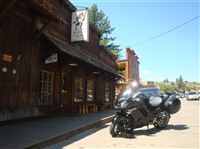 A few friends are thinking about getting their motorcycle licenses so there have been quite a few chats about safety floating around the lunch table. I decided to do some research and figure out just what the statistics tell us about riding a motorcycle.
A few friends are thinking about getting their motorcycle licenses so there have been quite a few chats about safety floating around the lunch table. I decided to do some research and figure out just what the statistics tell us about riding a motorcycle.
It’s difficult to collect unbiased statistics and get recent figures, but the key fact seems to be that motorcycles have a fatality rate 35 times greater per mile travelled than passenger cars. If that seems excessively dangerous to you, consider the motorcycle fatality rate is only about twice that of the bicycle rate. Any time you’re on the street without a big metal cage around you, you’re more vulnerable.
What causes most of the accidents? Unsurprisingly to most motorcycle riders, three fourths of accidents involve a car. Of those accidents, two thirds are because the other driver violated the right of way of the motorcycle. Failure of car drivers to recognize motorcycles is one of the most common dangers I face. (That’s why I installed the air horn on my bike!) Intersections are the most likely location for accidents.
So which types of riders are most likely to have accidents and what can you do to improve your odds?
- Riders between 16 and 24 are over-represented in the statistics and ages 30 to 50 are under represented and female riders are significantly over represented.
- Craftsmen, laborers, and students comprise most of the accident-involved motorcycle riders. Professionals, sales workers, and craftsmen are under represented and laborers, students and unemployed are over- represented in the accidents.
- Motorcycle riders with previous recent traffic citations and accidents are over represented in the accident data.
- The motorcycle riders involved in accidents are essentially without training; 92% were self-taught or learned from family or friends.
- More than half of the accident-involved motorcycle riders had less than 5 months experience on the accident motorcycle, although the total street riding experience was almost 3 years. Motorcycle riders with dirt bike experience are significantly under represented in the accident data
- Almost half of the fatal accidents show alcohol involvement.
- Motorcycles equipped with fairings and windshields are under represented in accidents
- Motorcycle riders in these accidents were significantly without motorcycle license, without any license, or with license revoked
- Seventy-three percent of the accident-involved motorcycle riders used no eye protection
- Sixty percent of the motorcyclists were not wearing safety helmets at the time of the accident
- Less than 10% of the motorcycle riders involved in these accidents had insurance of any kind to provide medical care or replace property
Which of those have causal relationships to accidents is unclear, but it is clear that you can do a few very important things to dramatically reduce your odds of getting in an accident:
- Take a training course from the Motorcycle Safety Foundation.
- Take it slow and easy as you put the first few thousand miles under your belt and always ride within your limits now matter how long you’ve been on the road.
- Don’t drink and drive. This is a no-brainer at any time, but even more so on the motorcycle. When I got my license, I decided that if I rode my motorcycle somewhere, I’d never have even one drink.
- Wear a helmet.
These all seem completely obvious, but if you start dong the math, you’ll see that a vast majority of the accident pie is made up of people who didn’t follow some or all of these four guidelines. Riding a motorcycle is inherently dangerous and it will never be a completely safe activity, but for your own sake, and for the sake of those who love you, use your head while you’re out enjoying yourself!
If you want to read more, check out the Harry Hurt investigation report from 2006. Much of the information in this post comes from that report. Don’t forget to read other sources though since we all know how statistics can be manipulated!
